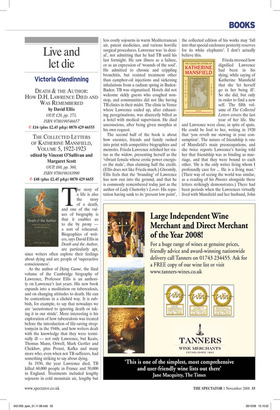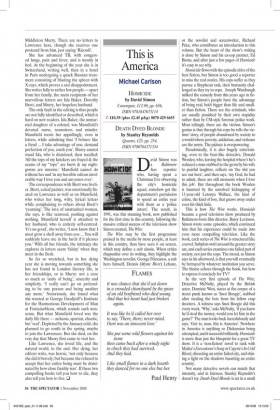Live and let die
Victoria Glendinning
DEATH BL THE AuTHoR: HoW D.H. LAWRENCE DIED AND WAS REMEMBERED by David Ellis OUP, £20, pp. 273, ISBN 9780199546657 ✆ £16 (plus £2.45 p&p) 0870 429 66555 THE CoLLECTED LETTERS oF KATHERINE MANSFIELD, VoLuME 5, 1922-1923 edited by Vincent O’Sullivan and Margaret Scott OUP, £60, pp. 360, ISBN 9780198183990 ✆ £48 (plus £2.45 p&p) 0870 429 6655 N The story of a life is also the story of a death, and one of the values of biography is that it enables us to die by proxy — a sort of rehearsal. Biographies of writers, says David Ellis in Death and the Author, are particularly apt, since writers often explore their feelings about dying and are people of ‘superactive consciousness’.
As the author of Dying Game, the final volume of the Cambridge biography of Lawrence, Professor Ellis is an authority on Lawrence’s last years. His new book expands into a meditation on tuberculosis, and on changing attitudes to death. He can be contentious in a clichéd way. It is rubbish, for example, to say that nowadays we are ‘accustomed to ignoring death or taking it in our stride’. More interesting is his exploration of how tuberculosis was treated before the introduction of life-saving streptomycin in the 1940s, and how writers dealt with the knowledge that they were terminally ill — not only Lawrence, but Keats, Thomas Mann, Orwell, Mark Gertler and Chekhov, plus Proust, Kafka and many more who, even when not TB sufferers, had something striking to say about dying.
In 1930, the year Lawrence died, TB killed 60,000 people in France and 50,000 in England. Treatments included lengthy sojourns in cold mountain air, lengthy but less costly sojourns in warm Mediterranean air, patent medicines, and various horrific surgical procedures. Lawrence was ‘in denial’, not admitting that he had TB until his last fortnight. He saw illness as a failure, or as an expression of ‘wounds of the soul’. He admitted to chronic and crippling bronchitis, but resisted treatment other than camphor-oil injections and sickening inhalations from a radium spring in BadenBaden. TB was stigmatised. Hotels did not welcome sickly guests who coughed nonstop, and communities did not like having TB clinics in their midst. The clinic in Vence where Lawrence ended up, after exhausting peregrinations, was discreetly billed as a hotel with medical supervision. He died unconscious, after being given morphia at his own request.
The second half of the book is about how enemies, friends and family rushed into print with competitive biographies and memoirs. Frieda Lawrence relished her status as the widow, presenting herself as the ‘vibrant female whose erotic power energises the male’, thus claiming half the credit. (Ellis does not like Frieda much.) Gloomily, Ellis feels that the ‘branding’ of Lawrence has now run into the ground, and that he
N 8SECATO 0/0/08
is commonly remembered today just as the author of Lady Chatterley’s Lover. His reputation having sunk to its ‘present low point’, the collected edition of his works may ‘fall into that special enclosure posterity reserves for its white elephants’. I don’t actually believe this.
Frieda stressed how dignified Lawrence had been in his dying, while saying of Katherine Mansfield that she ‘let herself go in her being ill’. So she did, but only in order to find a new self. The fifth volume of The Collected Letters covers the last year of her life. She and Lawrence were close, in spite of spats. He could be foul to her, writing in 1920 that ‘you revolt me stewing in your consumption’. The nature of friendship is one of Mansfield’s main preoccupations, and she twice reports Lawrence’s having told her that friendship was as binding as marriage, and that they were bound to each other. ‘He is the only writer living whom I profoundly care for ... He is a living man.’ (Their way of seeing the world was similar, as a reading of his Pansies alongside these
2 age
letters strikingly demonstrates.) There had been periods when the Lawrences virtually lived with Mansfield and her husband, John Middleton Murry. There are no letters to Lawrence here, though she receives one postcard from him, just saying ‘Ricordi’.
She has advanced TB, with congested lungs, pain and fever, and is mostly in bed. At the beginning of the year she is in Switzerland, writing well, then in a hotel in Paris undergoing a quack Russian treatment consisting of blasting the spleen with X-rays, which proves a sad disappointment. She writes fully to rather few people — apart from her family, the main recipients of her marvellous letters are Ida Baker, Dorothy Brett, and Murry, her hopeless husband.
The only fault in the editing is that people are not fully identified or described, which is hard on new readers. Ida Baker, the unmarried daughter of a colonel, was Mansfield’s devoted nurse, seamstress and minder. Mansfield treats her appallingly, even in letters, while admitting that ‘I behave like a fiend ... I take advantage of you, demand perfection of you, crush you’. Murry cannot stand Ida, who is dismissed, then recalled: ‘All the tops of my knickers are frayed & the seams of my “tops” are burst & my nightgowns are unsewn.’ Mansfield cannot do without her and ‘in my horrible odious intolerable way I love you and am yours ever’.
The correspondence with Brett was livelier. Brett, a deaf painter, was emotionally fixated on Lawrence as well as on Mansfield, who writes her long, witty, lyrical letters while complaining to others about Brett’s ‘yearning’. The love of unattached women, she says, is like seaweed, pushing against nothing. Mansfield herself is attached to her husband, who is entirely self-centred. ‘It’s no good’, she writes, ‘I now know that I must grow a shell away from you ... You will suddenly leave me in the lurch if it pleases you.’ With all her friends, the intimacy she explores in letters seem ‘falsity’ when they meet in the flesh.
So far so wretched, but in her dying year she is moving towards something she has not found in London literary life, in her friendships, or in Murry: not a cure so much as ‘unity of being’, sincerity and simplicity. ‘I really can’t go on pretending to be one person and being another any more.’ Notoriously, she found what she wanted at George Gurdjieff’s Institute for the Harmonious Development of Man at Fontainebleau, which sounds such nonsense. But what Mansfield loved was the daily life there — arduous, spartan, chaotic, but ‘real’. Depleted by the January cold, she planned to go south in the spring, maybe to join the Lawrences. But she died, on the very day that Murry first came to visit her.
Like Lawrence, she loved life, and the natural world, to the end. Her dying, her editors write, was heroic, ‘not only because she did it bravely, but because she refused to accept that her entire being must be dominated by how close finality was’. If these two compelling books tell you how to die, they also tell you how to live. q



































































































 Previous page
Previous page